
From the principle already adduced, namely, the regular and gradual elevation
o f this part o f the continent, 1 should have judged from the small altitude o f
the beds at Punta Alta, that the formation had not been very ancient. The conclusion
here arrived at, concerning the age o f these fossil mammalia, is nearly the
same, with that, inferred respecting those entombed in the Pampa s; and it will
hereafter be shown, that some o f the species are common to the two districts.
We may suppose, that whilst the ancient rivers o f the Pla ta occasionally carried
down the carcasses o f animals existing in that country, and deposited them in
the mud o f the estuary; other animals inhabited the plains round the Sierra de la
Ventana, and that lesser streams, acting together with the currents o f a large
bay, drifted their remains towards a point, where sand and shingle were accumulating
into a shoal. The whole area has since been elevated : the estuary mud
of the former rivers has been converted into wide and level plains ; and the shoals
o f the ancient Bahia Blanca now form low headlands on the present coast.
The third locality, which I have to specify, is Port St. Julian, in latitude 49°
15' on the coast o f Southern Patagonia. The tertiary plains o f that country
are modelled into a succession o f broad and level terraces, wliich abut one above
the other ; and where they approach the coast, are generally cut off by a line o f
precipitous cliff. The whole surface is thickly covered by a bed o f gravel, composed
o f various kinds o f porphyries, and probably originating from rocks situated
within the Cordillera. The lower part o f the formation consists o f several
varieties o f sandstone, and contains many fossil shells, the greater number of
which are not found in a living state.
The south side o f Port St. Julian is formed by a spit o f flat land, o f nearly a
hundred feet in h e ig h t; and on its surface ex isting spe cie s o f littoral shells are
abundantly scattered. The gravel is there covered (a circumstance which 1 did
not observe in scarcely any other locality) by a thin but irregular bed o f a sandy
or loamy soil, which likewise fills up hollows or channels worn through it. In the
largest o f these channels the remains o f the sing le fossil quadruped, which was
here discovered, were embedded. The skeleton probably was at first p e r fe c t;
but the sea having washed away part o f the cliff, has removed many o f the
bones,—the remaining ones, however, still occupying their proper relative position
to each other. I am inclined to attribute the origin of this earthy matter, to the
mud which might have accumulated in channels, and on the surface of the
gravel, if this part o f the plain had formerly existed as a harbour, such as
Port St. Julian is at the present day. The Guanaco, the only large animal
now inhabiting the wild plains o f Patagonia, often wanders over the extensive
flats, which are left dry at the head o f the harbour during ebb tide : we may
imagine that the fossil animal, whilst in a lik e manner crossing the ancient bay,
fell into one o f the muddy creeks, and was there buried.
I have stated that ex isting species o f she lls are scattered over the surface of
this plain ; namely, Mylihis 3Iagellanicus; a second and undescribed species,
now living on the beach ; M . edulis; P a te lla deaurala; and on another part of the
coast, but having similar geological relations, Fusus Magellarucus; Vohita aiiciUa;
Qxai a. Ba lan iis:—all these shells are among the commonest now living on this
coast. Although they must have been ly ing exposed to the atmospheric changes
for a very long period, they still partially retain their different colours. From
these facts we know, with certainty, that the superficial deposit, containing the
remains o f the quadruped, has been elevated above the sea, within the recent
period. From the structure o f the step-like plains, which front the coast, it is
certain that each step must have been modelled, subsequently to the elevation of
the one standing above i t ; and, as the same recent shells occur on two higlier
plains, we may, with safety, conclude, that the earthy matter, forming the surface
o f this lower one, together with its embedded skeleton, was deposited long
after the existenc e o f the present species, still inhabitants o f the sea. According,
therefore, to the chronology, taken from the duration o f species among the
molluscs, the fossil quadruped o f Port S t. Julian must have been coeval, or
nearly so, with those from Bahia Blanca.
Having now briefly described the principal circumstances in the geology of
the three districts, to which I at first alluded, I will conclude, b y observing, that
the fossil mammalia o f La Pla ta , Bahia Blanca, and Port St. Julian, must all have
lived during a very modern period in the geological history o f the world. It is not
the proper place in this work to enter on any speculations, concerning the cause o f
the extinction o f so many gigantic animals. I will only here add, that there is the
strongest evidence against admitting the theory o f a period of overwhelming
violence, by whicli the inhabitants o f the land could have been swept away, and